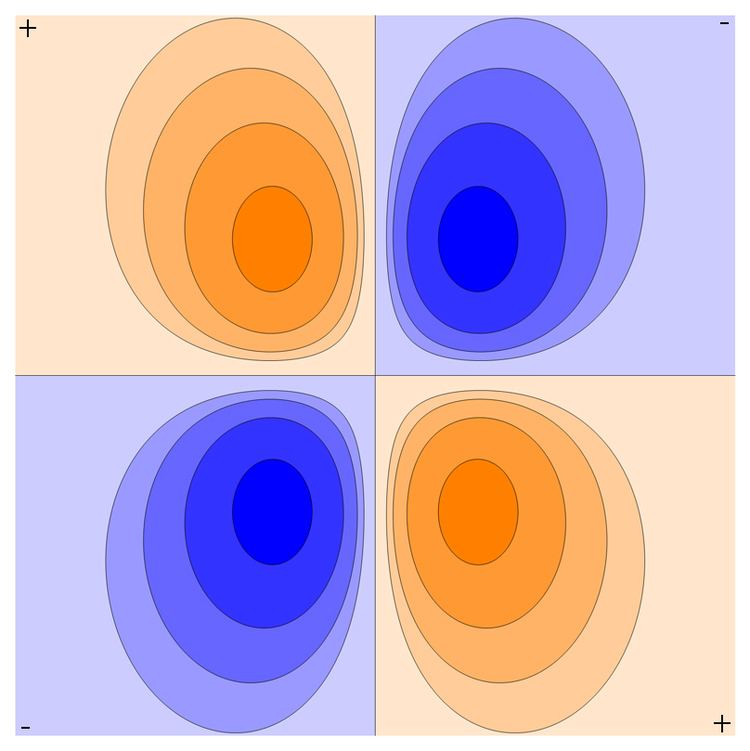 | ||
A quadrupole or quadrapole is one of a sequence of configurations of—for example—electric charge or current, or gravitational mass that can exist in ideal form, but it is usually just part of a multipole expansion of a more complex structure reflecting various orders of complexity.
Contents
Mathematical definition
The quadrupole moment tensor Q is a rank-two tensor (3x3 matrix) and is traceless (i.e.
For a discrete system of point charges (or masses in the case of a gravitational quadrupole), each with charge
The indices
For a continuous system with charge density (or mass density)
As with any multipole moment, if a lower-order moment (monopole or dipole in this case) is non-zero, then the value of the quadrupole moment depends on the choice of the coordinate origin. For example, a dipole of two opposite-sign, same-strength point charges (which has no monopole moment) can have a nonzero quadrupole moment if the origin is shifted away from the center of the configuration (exactly between the two charges); or the quadrupole moment can be reduced to zero with the origin at the center. In contrast, if the monopole and dipole moments vanish, but the quadrupole moment does not (e.g., four same-strength charges, arranged in a square, with alternating signs), then the quadrupole moment is coordinate independent.
If each charge is the source of a "
where R is a vector with origin in the system of charges and n is the unit vector in the direction of R. Here,
Electric quadrupole
The simplest example of an electric quadrupole consists of alternating positive and negative charges, arranged on the corners of a square. The monopole moment (just the total charge) of this arrangement is zero. Similarly, the dipole moment is zero, regardless of the coordinate origin that has been chosen. But the quadrupole moment of the arrangement in the diagram cannot be reduced to zero, regardless of where we place the coordinate origin. The electric potential of an electric charge quadrupole is given by
where
Generalization: Higher multipoles
An extreme generalization ("point octopole") would be: Eight alternating point charges at the eight corners of a parallelepiped, e.g. of a cube with edge length a. The "octopole moment" of this arrangement would correspond, in the "octopole limit"
Magnetic quadrupole
All known magnetic sources give dipole fields. However, to make a magnetic quadrupole it is possible to place four identical bar magnets perpendicular to each other such that the north pole of one is next to the south of the other. Such a configuration cancels the dipole moment and gives a quadrupole moment, and its field will decrease at large distances faster than that of a dipole.
An example of a magnetic quadrupole, involving permanent magnets, is depicted on the right. Electromagnets of similar conceptual design (called quadrupole magnets) are commonly used to focus beams of charged particles in particle accelerators and beam transport lines, a method known as strong focusing. The quadrupole-dipole intersect can be found by multiplying the spin of the unpaired nucleon by its parent atom. There are four steel pole tips, two opposing magnetic north poles and two opposing magnetic south poles. The steel is magnetized by a large electric current that flows in the coils of tubing wrapped around the poles.
A changing magnetic quadrupole moment produces electromagnetic radiation.
Gravitational quadrupole
The mass quadrupole is analogous to the electric charge quadrupole, where the charge density is simply replaced by the mass density and a negative sign is added because the masses are always positive and the force is attractive. The gravitational potential is then expressed as:
For example, because the Earth is rotating, it is oblate (flattened at the poles). This gives it a nonzero quadrupole moment. While the contribution to the Earth's gravitational field from this quadrupole is extremely important for artificial satellites close to Earth, it is less important for the Moon, because the
The mass quadrupole moment is also important in general relativity because, if it changes in time, it can produce gravitational radiation, similar to the electromagnetic radiation produced by oscillating electric or magnetic dipoles and higher multipoles. However, only quadrupole and higher moments can radiate gravitationally. The mass monopole represents the total mass-energy in a system, which is conserved—thus it gives off no radiation. Similarly, the mass dipole corresponds to the center of mass of a system and its first derivative represents momentum which is also a conserved quantity so the mass dipole also emits no radiation. The mass quadrupole, however, can change in time, and is the lowest-order contribution to gravitational radiation.
The simplest and most important example of a radiating system is a pair of mass points with equal masses orbiting each other on a circular orbit (an approximation to e.g. special case of binary black holes). Since the dipole moment is constant, we can for convenience place the coordinate origin right between the two points. Then the dipole moment will be zero, and if we also scale the coordinates so that the points are at unit distance from the center, in opposite direction, the system's quadrupole moment will then simply be
where M is the mass of each point, and
Just as electric charge and current multipoles contribute to the electromagnetic field, mass and mass-current multipoles contribute to the gravitational field in general relativity, causing the so-called "gravitomagnetic" effects. Changing mass-current multipoles can also give off gravitational radiation. However, contributions from the current multipoles will typically be much smaller than that of the mass quadrupole.
